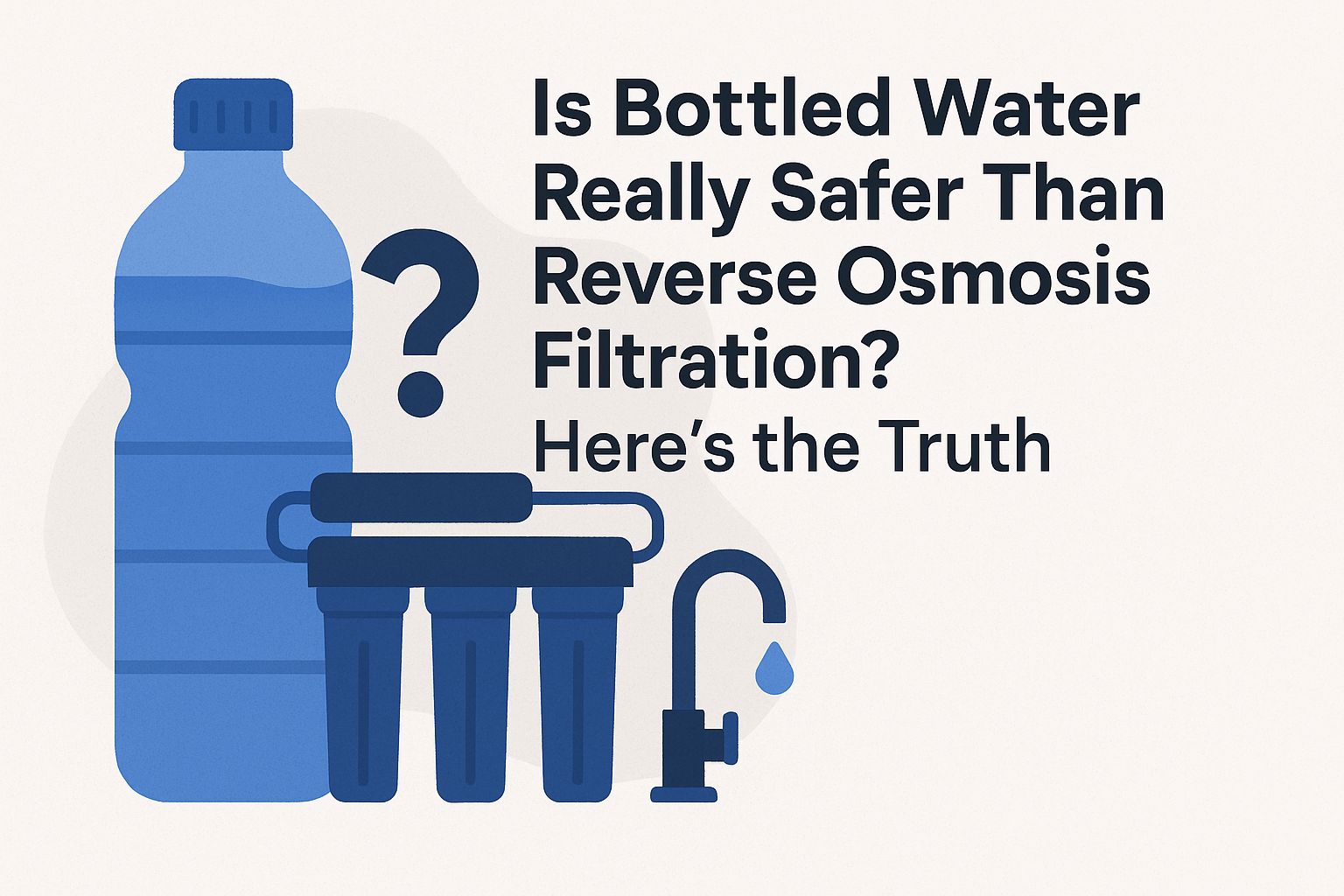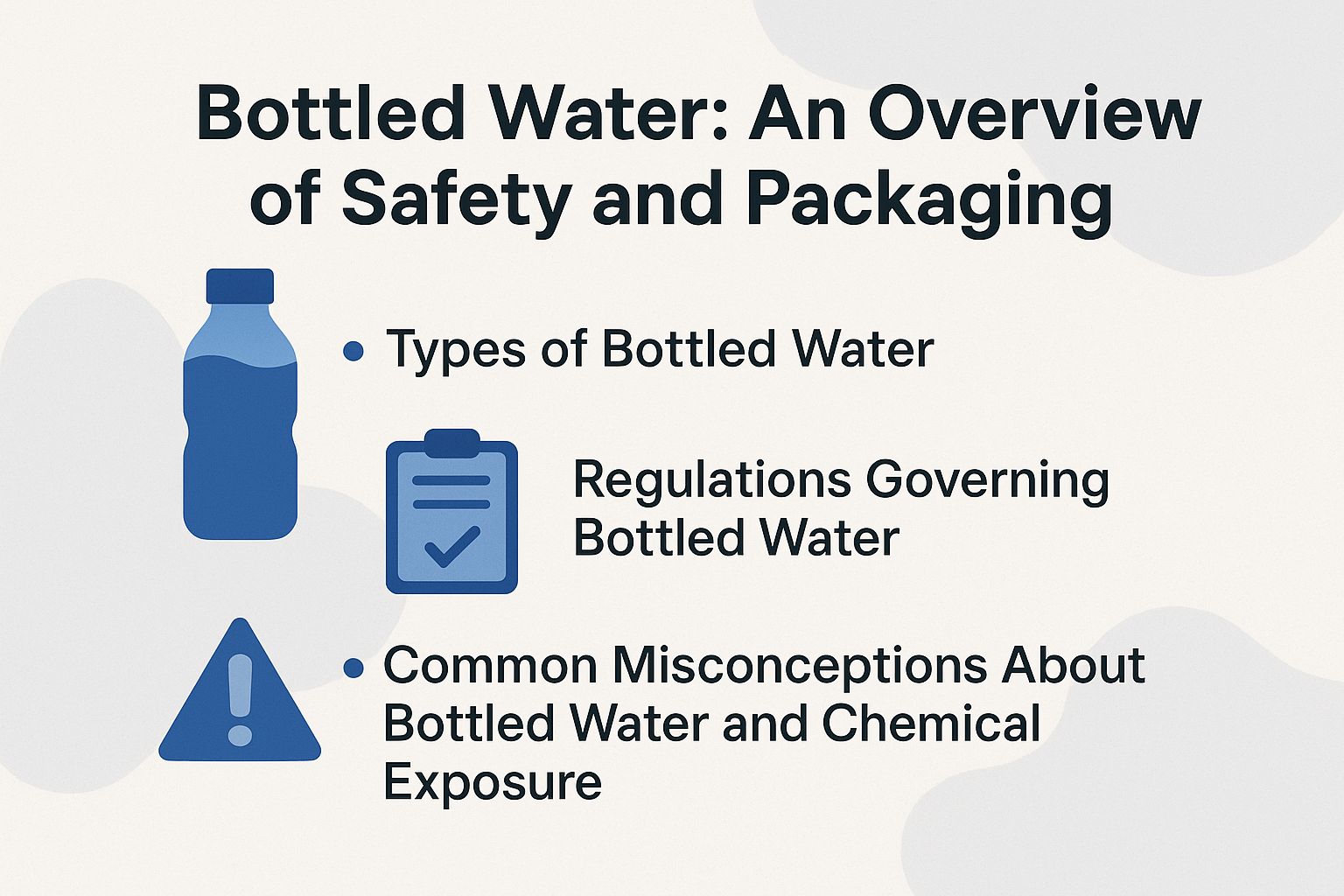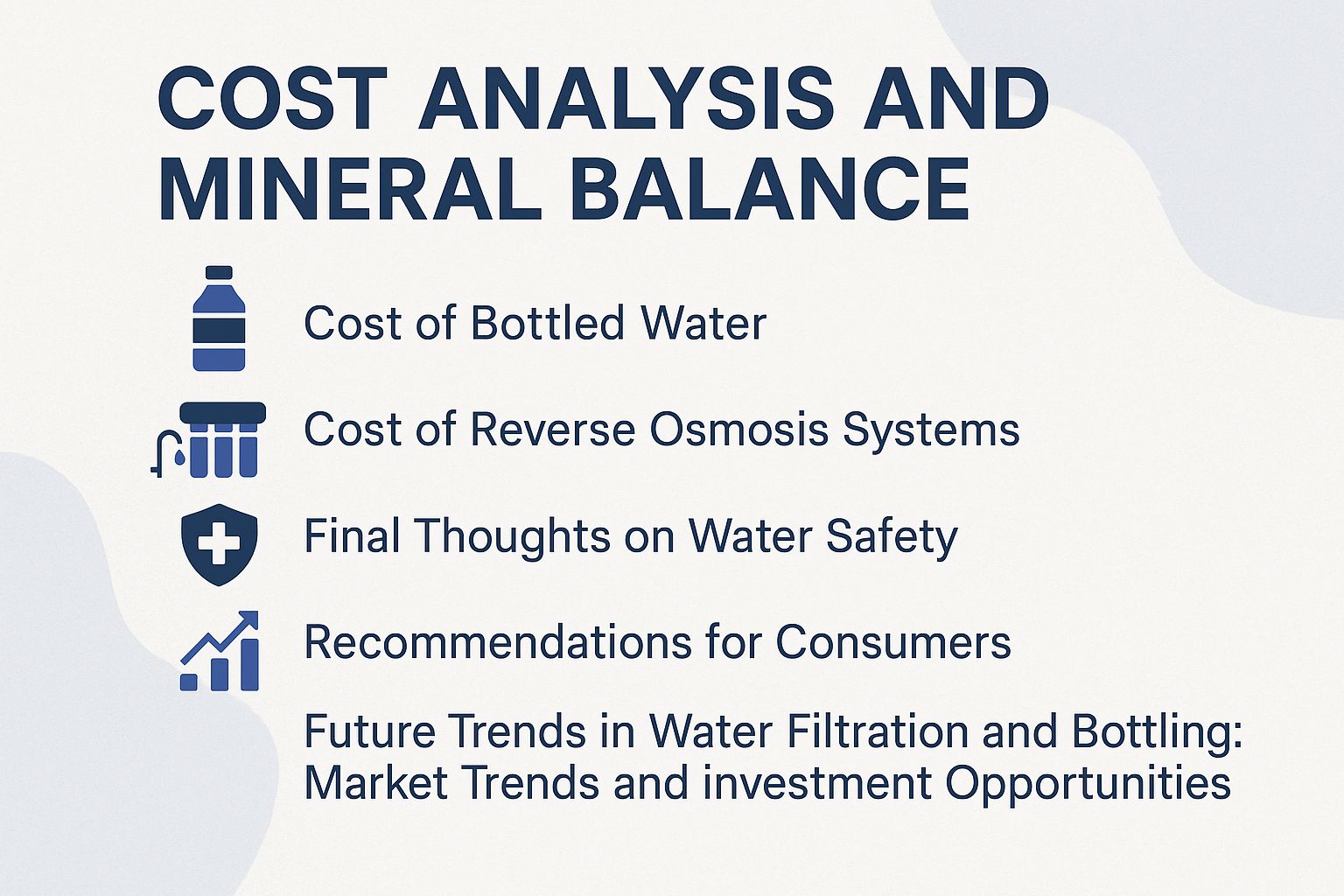
Is Bottled Water Really Safer Than Reverse Osmosis Filtration? Here’s the Truth
When you crack open a bottle of water, do you think it’s the safer choice? A lot of people think bottled water is better than water from reverse osmosis filters. But is this really true? Knowing the details of water quality is more important now. Learn more about the different kinds of bottled water, how reverse osmosis works, and what really keeps your water clean, highlighting why filtration methods matter. You might be surprised by the facts lurking beneath the surface.
The Importance of Water Quality and Consumer Awareness
Keeping water clean is very important; bad water can cause serious health problems and public health crises, with more than 2 million deaths each year from illnesses spread by water, as stated by the WHO.
Contaminated water may have bacteria and viruses that cause diseases such as cholera, dysentery, and typhoid fever. For instance, in 2010, an earthquake in Haiti led to a cholera outbreak affecting over 650,000 people, underscoring the need for reliable water sources.
Effective monitoring tools, like water quality test kits (such as those from Hach or LaMotte), can help communities assess the safety of their water supply. Regular testing finds contaminants and helps improve safety standards and quality assurance, saving lives and lowering healthcare costs. For those wondering about the role of filtered water in maintaining safety, discover why water delivery services matter in ensuring clean water accessibility.
Overview of Bottled Water, Reverse Osmosis, and Filtration Technology
Bottled water is packaged drinking water often sold in plastic or glass bottles. It comes in various forms, including spring water, purified water, and mineral water. Reverse osmosis is a process used to remove impurities from water. It forces water through a membrane, leaving contaminants behind. This method is effective for filtering out a wide range of substances, including salts, bacteria, and other impurities. Filtration technology includes various methods used to clean water. These methods can include physical barriers, chemical processes, and biological mechanisms to remove unwanted particles and contaminants. Common filtration methods include carbon filters, UV light, and sediment filters.
In 2022, sales of bottled water in the U.S. exceeded $18 billion, and home water purification systems using reverse osmosis are in demand, valued at more than $600 million each year.
The increasing consumer demand for clean and safe drinking water is driving both the bottled water market and home purification technologies, highlighting the importance of consumer choices and lifestyle choices.
As people become more conscious about health, many opt for reverse osmosis systems because they effectively remove impurities such as lead and chlorine. For instance, brands like Aquasana and APEC offer reliable systems priced between $200 and $500.
The preference for bottled water, often seen in premium brands like Fiji and Evian, reflects a trend towards convenient hydration options. This combination of ease and security shows changing customer priorities in the drink industry, focusing on convenience vs safety.
Bottled Water: An Overview of Safety and Packaging

Learning about bottled water means knowing the various kinds and the government standards and certifications that control them. Related insight: Top Bottled Water Brands: The Good, Bad, and the Ugly can provide additional information on some of the most popular options available.
Types of Bottled Water
There are various types of bottled water, including spring water, mineral water, and purified water, each catering to different consumer preferences and health needs.
Spring water is sourced directly from natural springs, often containing beneficial minerals like calcium and magnesium. It tends to have a fresh taste and is often favored for its natural qualities.
Mineral water is full of important minerals, usually having high amounts of magnesium and calcium. This makes it a common choice for people wanting to increase their nutrient intake.
Purified water is processed using methods like reverse osmosis or distillation to remove impurities, making it a clean choice with a neutral taste. Choosing the right type depends on individual health goals and taste preferences.
Regulations Governing Bottled Water
Bottled water is regulated by the FDA, which sets standards equivalent to those for tap water, ensuring safety and quality for consumers.
These rules address important topics like the quality of the water source, product labels, and substances that can pollute.
For instance, bottled water must meet health-based standards for microorganisms, chemicals, and physical substances. Compliance is monitored through regular inspections, laboratory analysis, and testing of products at various stages of production.
Manufacturers are required to report any violations, and the FDA can enforce recalls if safety concerns arise. Knowing these rules helps people choose the right bottled water.
Common Misconceptions About Bottled Water and Chemical Exposure
Many consumers hold misconceptions about bottled water, such as the belief that it is always purer than tap water, despite studies showing otherwise.
In fact, a study by the Natural Resources Defense Council revealed that about 25% of bottled water is actually derived from municipal sources, often subject to the same regulations as tap water.
The U.S. Environmental Protection Agency states that tap water goes through strict testing and regular checks. Many assume bottled water has a longer shelf life, but plastic can leach harmful chemicals over time, especially when exposed to heat.
Considering these points, consumers should critically assess their choices between bottled and tap water.
Reverse Osmosis Filtration: How It Works and Hydration Options

Reverse osmosis is a popular filtration method that removes up to 99% of impurities, making it a great choice for households wanting clean drinking water. If you’re exploring options for an eco-friendly water system at home or in the office, you might find our insights on eco-friendly water sources especially helpful.
How Reverse Osmosis Works
Reverse osmosis uses a unique filter to get rid of things like lead, chlorine, and bacteria, making water cleaner.
The system operates in several stages.
- First, water is pre-filtered to remove larger particles, enhancing the efficiency of the membrane.
- Next, under pressure, water passes through the semi-permeable membrane, where it separates pure water from contaminants.
- After filtration, the water undergoes a final post-filtering stage to eliminate any remaining tastes or odors.
Having a reverse osmosis system at home can offer cleaner drinking water, improved taste, and health benefits, making it a good choice for many families.
Benefits of Reverse Osmosis Filtration
Reverse osmosis filtration improves water by taking out harmful substances and enhancing its taste, which builds consumer trust.
Reverse osmosis systems effectively get rid of impurities. For example, they can remove up to 99% of lead, chlorine, and fluoride, improving the safety and taste of water.
Cleaner water can offer potential health benefits, such as reduced risk of gastrointestinal issues and improved hydration efficiency. To keep your system working well, do regular maintenance and change filters often. Companies like Home Master and APEC offer dependable systems with straightforward instructions, ensuring efficient filtering and upkeep.
This keeps your home water clean and safe to drink.
Drawbacks of Reverse Osmosis Filtration and Environmental Impact
Reverse osmosis, while useful, also has some downsides. It removes healthy minerals and wastes water during the process.
A main drawback of reverse osmosis is that it can take out important minerals like calcium and magnesium from the water. This can lead to an acidic pH in the water, which may not be ideal for health over time.
Reverse osmosis systems typically use three gallons of water to produce one gallon of clean water. For those interested in understanding the broader context of water filtration in offices, our Ultimate Guide to Office Water Filtration Systems provides valuable insights.
To keep these systems working well and stop bacteria from growing, replace filters every 6-12 months. This will help manage running costs.
Comparing Safety: Bottled Water vs. Reverse Osmosis and Its Effect on the Environment

Reverse osmosis systems are popular for cleaning water by removing impurities. While they work well, they also bring up environmental issues. The process needs a lot of water and energy, which results in waste and higher energy use. Also, the release of concentrated waste can damage ecosystems if not handled properly. As the demand grows, it is important to think about these impacts and find ways to reduce the harm to the environment.
When comparing bottled water to reverse osmosis, safety means examining the dangers from bacteria and chemical contaminants.
Microbial Contamination Risks
Microbial contamination remains a significant concern, with studies revealing that 30% of bottled water brands tested positive for bacteria.
Just like other systems, reverse osmosis (RO) units can have germs if they are not properly maintained. A study found that 14% of home RO systems had detectable levels of bacterial contamination.
To reduce these risks, it is important to clean both bottled water storage areas and RO units often.
- Using a mixture of vinegar and water for cleaning or employing UV sterilization can help eliminate harmful microbes, enhancing filtration effectiveness.
- Check the expiration dates on bottled water and replace the filters in RO systems as recommended, usually every 6-12 months.
Chemical Contaminants
Chemical contaminants such as BPA from plastic bottles and heavy metals in tap water pose different risks, necessitating careful comparison.
Bottled water often harbors contaminants like bisphenol A (BPA), which can leach from plastic packaging, while tap water may contain lead and arsenic, particularly in older plumbing systems.
To lower these risks, many people install reverse osmosis (RO) systems. These devices filter out nearly all contaminants, including toxic metals and chemicals. For instance, an RO system can remove up to 99% of lead, providing a reliable source of clean water.
People should check the source of the water and its filtration method to confirm it has the necessary safety and health certifications for drinking.
Environmental Considerations and Ecological Concerns
Dumping over 1 million plastic bottles every minute globally creates a huge amount of plastic waste, which damages the environment.
Reverse osmosis systems are a greener choice. These systems filter tap water, removing contaminants and reducing reliance on bottled water.
They require energy for operation, which contributes to a carbon footprint. When analyzing sustainability, consider factors like how often you purchase bottled water and the environmental cost of producing these materials.
For example, bottled water results in more plastic waste, while a reverse osmosis system initially consumes energy and water, but in the long run, it produces less waste, lowering environmental impact.
Public Perception and Trust in Water Filtration Systems
What people think about bottled water and reverse osmosis systems depends on their views on safety, convenience, and environmental impact. For a broader understanding of these options, see also our Office Water Service Buyer’s Guide which covers types, options, and costs.
Consumer Attitudes Towards Bottled Water and Filtration Systems
Surveys indicate that nearly 68% of consumers prefer bottled water over tap water due to perceived safety and taste benefits.
This preference is largely influenced by factors such as convenience, brand marketing, and health consciousness.
For example, brands like Dasani and Aquafina emphasize purification processes, reassuring consumers about safety. Studies show that convenience is paramount; 70% of survey respondents cited on-the-go consumption as a reason for choosing bottled options over tap.
The availability of water in stylish or eco-friendly packaging also sways purchasing decisions, appealing to both aesthetic tastes and environmental concerns, including considerations of ecological sustainability and recycling practices.
Trust in Reverse Osmosis Systems
More people trust reverse osmosis systems now, with 75% of users feeling happier because they think their drinking water is cleaner and safer. They value how well these systems remove impurities and harmful substances from the water.
People are happy because data shows that reverse osmosis systems can remove up to 99% of contaminants, handling possible issues from microplastics and chemical leakage from other sources.
Many people believe the taste improves and smells are eliminated, which makes the water more enjoyable compared to bottled water.
Choosing reverse osmosis systems can save money in the long run. This is clear when you compare the monthly expense of buying bottled water to the upfront cost of a home filtration system. It’s a good decision for people concerned about health.
These factors are why users rely on reverse osmosis technology.
Cost Analysis and Mineral Balance

Comparing the expenses of bottled water and reverse osmosis shows that bottled water costs about $1.50 per gallon, while filtered water costs around $0.10. They differ in mineral content and pH levels, which affect taste and health.
Cost of Bottled Water
The average cost of bottled water in the U.S. is around $1.50 per liter, translating to significant annual expenses for daily consumers who may not be aware of the bottled water industry details.
For regular drinkers, this amounts to approximately $550 annually per person. In contrast, tap water costs just a fraction, typically about $0.002 per liter, emphasizing the potential long-term effects on household finances and energy consumption.
To reduce bottled water expenses, consider investing in a quality reusable water bottle (around $20) and a filtration system, like a Brita pitcher ($30), which can significantly improve taste and safety.
Over time, using a filtration system and tap water can save hundreds, demonstrating a sustainable and economical choice while supporting urban water sources and quality control efforts.
Cost of Reverse Osmosis Systems
The initial price for a reverse osmosis system ranges from $150 to $600, and annual upkeep is about $50.
Installation fees can vary significantly, typically ranging from $100 to $300 depending on your local plumber’s rates and the complexity of your setup.
Over time, using an RO system can lead to substantial savings. On average, families spending $50 a month on bottled water can save over $600 annually after accounting for the initial setup costs.
This change cuts down your impact on the environment and gives you a dependable supply of clean water at home, aligning with environmental regulations and ecological sustainability goals.
Final Thoughts on Water Safety
Water safety is paramount; consumers are advised to choose based on thorough research to avoid health risks associated with contaminated water, considering water treatment options and trace elements.
Informed choices regarding water sources can significantly impact health. Begin by testing your water for contaminants using kits from brands like Home Depot, which typically cost around $20.
Research local water reports to understand common issues in your area. If you suspect lead or other heavy metals, consider investing in a quality filtration system, such as Brita or Berkey, which can remove a range of pollutants, ensuring adherence to health guidelines and consumer safety standards.
Regularly check recall alerts from the Environmental Protection Agency (EPA) or local health departments to keep your water supply safe, and be aware of waterborne diseases that may arise from neglected water access issues.
Recommendations for Consumers
People should test the quality of their water and think about using methods like reverse osmosis to make well-informed choices about their drinking water.
- Start by using a home test kit, available for $20-$50, to measure contaminants like lead, chlorine, and bacteria.
- Consider installing a reverse osmosis system. It usually costs from $150 to $500, based on the type and how it needs to be installed.
- For a more budget-friendly option, activated carbon filters can remove many impurities for around $30.
Using eco-friendly practices, such as collecting rainwater for irrigation or utilizing refillable water bottles, also promotes sustainable hydration choices while protecting your health, reinforcing product labeling transparency and recycling benefits.
Upcoming Changes in Water Purification and Packaging: Market Changes and Investment Possibilities
Upcoming developments in water filtration focus on greener packaging and improved filtration methods, expected to influence what consumers choose in the coming years, driven by market trends and investment in new purification technology.
For instance, companies are investing in biodegradable bottle materials, reducing plastic waste significantly. New technology such as reverse osmosis systems purifies water using less energy than older methods.
Many brands are using multi-level filtration systems, which improve taste and remove contaminants, including absorption of trace elements. Consumers increasingly prefer refill stations, encouraging sustainable practices while saving costs.
By 2030, it’s predicted that 40% of bottled water will be produced by these new systems, showing a major change towards being more environmentally friendly and health-focused.
About the Author
I’m Jordan Matthews, a University of California, Berkeley graduate with a degree in Environmental Science. Over the past 18 years, I’ve helped companies across Seattle improve sustainability and employee wellness through smarter infrastructure and thoughtful planning. As a writer and editor for Office Water Services, I’m passionate about helping organizations align their values with the way they hydrate, build, and grow.
Leave a Reply